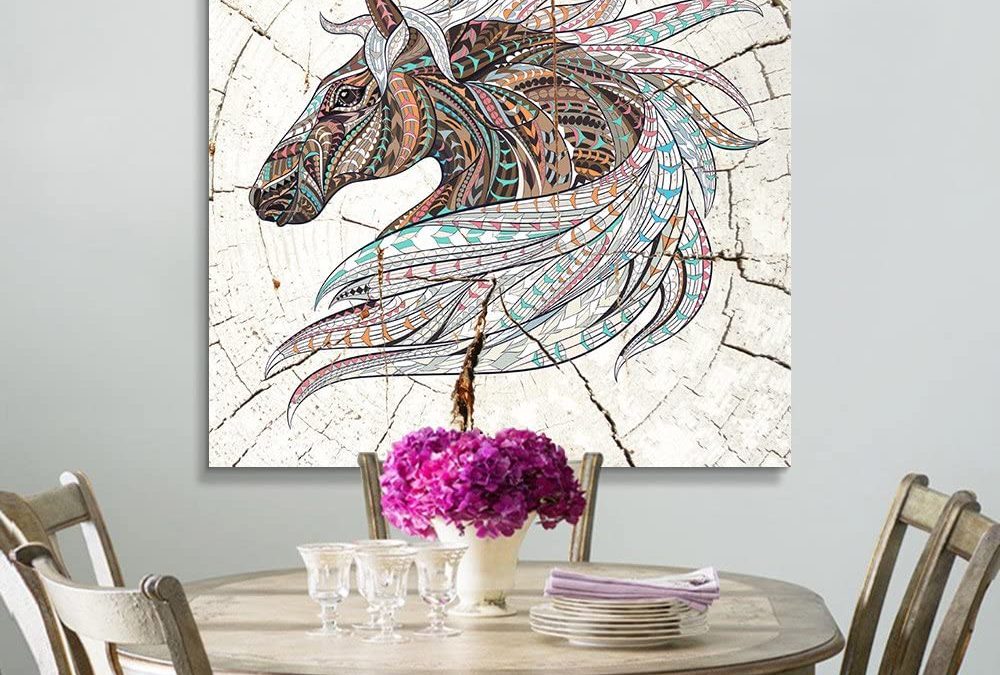Horses are one of the most majestic animals on Earth. Long legged, strong-willed and athletic, horses have proven themselves to be valuable tools and companions for much of modern history. Horses belong to a type of mammal species called “ungulates”. Ungulates are any large mammal with hooves. This group is also comprised of cattle, moose, deer and giraffes. Horses are also close relatives to the donkey and the zebra. Read below to find out some interesting horse wall art facts!
Breeds
Although there is only one species of domesticated horse, there are nearly 400 different horse breeds throughout the world. Various breeds have different adaptations that allow them to perform different tasks. Horses can range in size, color, shape of head, and even coat texture. Small horses are commonly known as ponies. Ponies are a distinct breeds of horse that grows no larger than four feet tall. Draft horses, the breed that most commonly works on farms, can grow to be over six feet tall. Read below for the next horse wall art fact.
Hooves
Did you know that horse hooves haven’t always existed? Hooves are an evolutionary adaptation. Ancient horses had around two to three toes on every “foot”, but due to harsh environments their toes were bred out of existence and replaced by hooves. Hooves are composed of keratin, a type of fibrous protein that human nails and hair are also made of. Horse hooves are somewhat fragile body parts; throughout a horse’s life, they are naturally shaved down by tough terrain. To protect these delicate hooves, horse owners often place metal horseshoes on the bottom of their hooves so that they are protected. Read below for the next horse wall art fact.
History

Horses were not always domesticated. In fact, they were some of the most difficult animals to domesticated. Originally, horses were wild animals that grazed for food in herds across the uninhabited plains of North America. These early horses were of all sizes and colors; they even differed in diets and preferred habitats. Ancient North American horses mysteriously disappeared 10,000 years ago, but many early horse breeds found ways to migrate across the world. Humans first tamed horses around 6,000 years ago in Asia. At first, horses were primarily used as livestock in the same way that cows are today; people treasured both horse meat and milk. Eventually humans saw their use as tools, and started using them for transportation and work. Read below for the next horse wall art fact.
Senses
Over their long existence, horses have adapted to life by forming some unique and highly developed senses. Horses tall ears allow them to have almost perfect hearing. Horses have the ability to move their ears forward and backward so that they can hear more sounds. A horse’s sense of smell is so strong that a female horse can locate her specific foal just from a slight scent. Ever tried sneaking up on a horse? Good lock. Their eyes are placed on either side of their head, giving them a nearly 360 degree field of vision. Read below for the next horse wall art fact.
Extinct
Speaking of ancient horses, did you know that a 1928 discovery helped to unearth information on a very interesting ungulate? A discovery of 200 fossils in Idaho helped to confirm the existence of a North American horse breed that is an ancestor to most breeds living today. Called the “Hagerman Horse”, this breed was closely related to and resembled the modern day zebra.
Conclusion
Used for transportation, work, combat, and sports, horses have permeated into nearly every facet of human life. Horses are valuable parts of modern living, and continue to be instrumental to human success. We hope that you enjoyed these amazing horse wall art facts!





